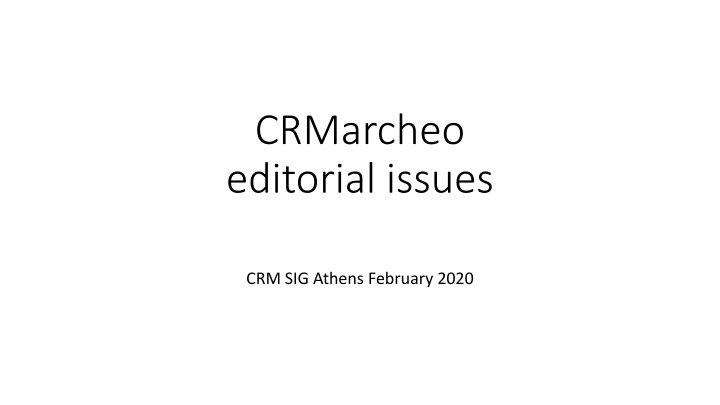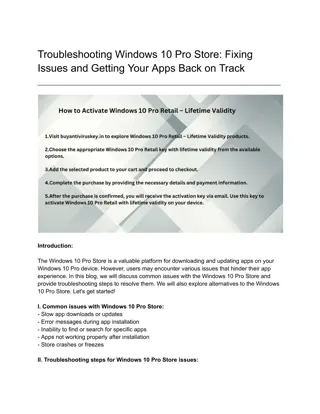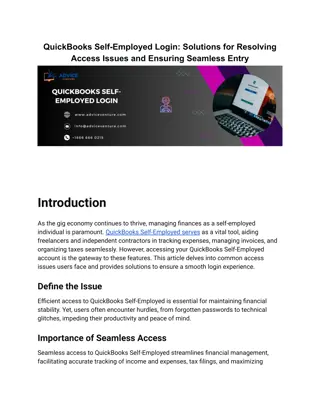
Archaeological Digital Excavation Documentation in Norway
The project, known as ADED, aims to establish an infrastructure for digitally born excavation data in Norway from 2018 to 2021. This includes structures, profiles, layers, and points with detailed textual and visual documentation. The data sets will be integrated into a searchable information system, enhancing access and preservation. The mapping process involves data export, format conversion, and compatibility with CRMarcheo for long-term storage and linked data purposes.
Download Presentation

Please find below an Image/Link to download the presentation.
The content on the website is provided AS IS for your information and personal use only. It may not be sold, licensed, or shared on other websites without obtaining consent from the author. If you encounter any issues during the download, it is possible that the publisher has removed the file from their server.
You are allowed to download the files provided on this website for personal or commercial use, subject to the condition that they are used lawfully. All files are the property of their respective owners.
The content on the website is provided AS IS for your information and personal use only. It may not be sold, licensed, or shared on other websites without obtaining consent from the author.
E N D
Presentation Transcript
CRMarcheo editorial issues CRM SIG Athens February 2020
The Archaeological Digital Excavation Documentation ADED An infrastructure for all digitally born excavation data sets in Norway Project period 2018 2021 Data sets with geo-references objects: Structures, profiles, layers, points Structural relationships between object Text and visual documentation of the objects The data sets will be included into a single searchable information system
Data mapping INTRASIS underlaying database is postgreSql + postGis Export the data to a INTRASIS near format for documentation Map the data to CRMarcheo compatible format This format will be a used as an import format for the common database Intermediat format for linked data, ARIADNEplus Long term storage format
Figure 4 from CRMarcheo 1.4.7 Fig. 4: Section drawing with A3 Stratigraphic Interfaces in square brackets [], A2 Stratigraphic Volume Unit in round brackets (), the surfaces S1 and S2 created through A1 Excavation Process Units using different methodologies and an A7 Embedding of a coin.
Figure 4 from CRMarcheo 1.4.7 A10 Excavation Interface A10 Excavation Interface Assume that S2 was create first, that is a mechanical layer cut through 2, 3, 18 and 19. How do we model the relation between S2 (A10 Excavation Interface) and 2, 3, 18 and 19 (A8 Stratigraphic Unit)? A more common example would be a vertical profile cut through 2, 3, 18 and 19 . The modelling issue is identical
The archeological structures and excavation E5 Event AP14 justified by E70 Thing E7 Activity S18 Alteration AP13 has stratigraphic relation E13 Attribute Assignment S10 Material Substantial A5 Stratigraphic Modification Event S17 Physical Genesis S11 Amount of Matter S1 Matter Removal S4 Observation AP9 took matter from A4 Stratigraphic Genesis E26 Physical Feature AP1 produced AP7 produced AP8 disturbed A1 Excavation Process Unit AP2 discarded E55 Place AP5 removed part or all of AP4 produced surface S20 Rigid Physical Feature AP11 has physical relation A8 Stratigraphic Unit S20 Rigid Physical Feature AP10 destroyed A3 Stratigraphic Interface A2 Stratigraphic Volume Unit A10 Excavation Interface S22 Segment of Matter AP12 is confined by AP15 is or contains remains of AP21 contains E18 Physical Thing S10 Material Substantial 7
The archeological structures and excavation E5 Event E7 Activity S18 Alteration AP13 has stratigraphic relation E13 Attribute Assignment A5 Stratigraphic Modification Event S17 Physical Genesis E70 Thing S1 Matter Removal S4 Observation S10 Material Substantial A4 Stratigraphic Genesis AP9 took matter from AP7 produced E55 Place E26 Physical Feature A1 Excavation Process Unit S11 Amount of Matter AP1 produced AP8 disturbed AP5 removed part or all of AP4 produced surface S20 Rigid Physical Feature AP11 has physical relation A8 Stratigraphic Unit S20 Rigid Physical Feature AP10 destroyed A3 Stratigraphic Interface A2 Stratigraphic Volume Unit A10 Excavation Interface S22 Segment of Matter AP12 is confined by AP15 is or contains remains of AP21 contains E18 Physical Thing S10 Material Substantial 8
The archeological structures and excavation E5 Event AP14 justified by E70 Thing E7 Activity S18 Alteration AP13 has stratigraphic relation E13 Attribute Assignment S10 Material Substantial A5 Stratigraphic Modification Event S17 Physical Genesis S11 Amount of Matter S1 Matter Removal S4 Observation A4 Stratigraphic Genesis E26 Physical Feature AP7 produced AP8 disturbed A1 Excavation Process Unit AP1 produced E55 Place AP5 removed part or all of AP4 produced surface S20 Rigid Physical Feature AP11 has physical relation A8 Stratigraphic Unit S20 Rigid Physical Feature AP10 destroyed A3 Stratigraphic Interface A2 Stratigraphic Volume Unit A10 Excavation Interface S22 Segment of Matter AP12 is confined by AP15 is or contains remains of AP21 contains E18 Physical Thing S10 Material Substantial 9
E5 Event S18 Alteration E7 Activity E11 Modification E63 Beginning of Existence AP13 has stratigraphic relation S17 Physical Genesis A5 Stratigraphic Modification Event S10 Material Substantial A4 Stratigraphic Genesis E12 Production













